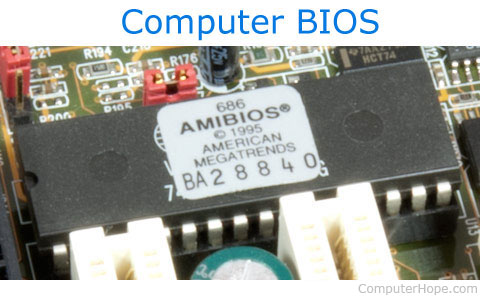BIOS
BIOS may refer to any of the following:
1. Short for Basic Input/Output System, the BIOS (pronounced bye-oss) is a ROM chip found on motherboards
that allows you to access and set up your computer system at the most
basic level. In the picture below, is an example of what a BIOS chip may
look like on your computer motherboard. In this example, this is a
picture of an early AMIBIOS, a type of BIOS manufactured by the AMI. Another good example of a BIOS manufacturer is Phoenix.

The BIOS includes instructions on how to load basic computer hardware and includes a test referred to as a POST
(Power On Self Test) that helps verify the computer meets requirements
to boot up properly. If the computer does not pass the POST, you will
receive a combination of beeps indicating what is malfunctioning within
the computer.
The four main functions of a PC BIOS
- POST - Test the computer hardware and make sure no errors exist before loading the operating system. Additional information on the POST can be found on our POST and Beep Codes page.
- Bootstrap Loader - Locate the operating system. If a capable operating system is located, the BIOS will pass control to it.
- BIOS drivers - Low level drivers that give the computer basic operational control over your computer's hardware.
- BIOS or CMOS Setup - Configuration program that allows you to configure hardware settings including system settings such as computer passwords, time, and date.
2. When referring to a person BIO, BIO's is short for biography
and is a term used to describe a brief description of a person. A short
biography or description of people who have affected the computer
industry can be found on our computer people section.
ACPI, BBS, BIO, BIOS shadow, BPB, CMOS, EFI, Firmware, Flash BIOS, FWH, Libreboot, Motherboard terms, NVRAM, PROM, UEFI

Komentar
Posting Komentar